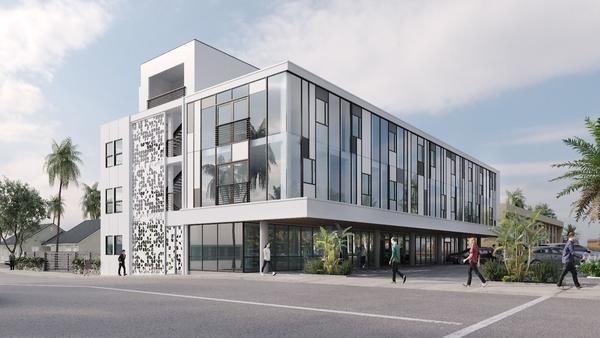Developing new projects in land-locked urban centers and dense outlying communities is on the rise, but it is in the form of adaptive reuse and infill development. Both concepts offer opportunities for development in areas where space is limited.
Adaptive reuse focuses on the redevelopment of an existing building. A new use is created for the building, which differs from its original purpose or use. Infill development is the process of developing vacant or under-used parcels within highly developed, existing urban areas.
Sometimes adaptive reuse and infill developments reuse a large structure to create a cohesive, mixed-use development that blends commercial, retail and residential spaces. Repurposing an existing building or property for a different use is not a new idea for retail and commercial projects.
In fact, Murfey Company is near completion of an adaptive reuse project in La Jolla. The multi-million dollar mixed-use development of the 18,330-square-foot former Nautilus Professional Building at 6902 La Jolla Boulevard will house Valley Farm Market, a high-quality specialty market, in its ground floor retail space, and 15 one- and two-bedroom luxury apartment with ocean views.
However, the concepts of adaptive reuse and infill development are on the rise in the apartment and hotel industries. One of the biggest reasons for this interest is that people enjoy living close to the city where there are plenty of options for dining, shopping, theater, and commute time between home and work generally is shorter.
There are numerous benefits to redesigning and rebuilding what already exists. Why does adaptive reuse and infill development work? Some of these benefits include the following.
- Economic development opportunities. These projects promote investment or reinvestment of underutilized buildings and vacant lots in downtown areas.
- Use of existing infrastructure. Resources such as water and sewer lines and streets reduce construction cost and disruption.
- Cost-efficiency. Adaptive reuse projects generally have shorter timelines, which means that developments are completed faster and generate a profit sooner.
- Neighborhood revitalization. Adaptive reuse and infill developments revitalize communities, reduce urban sprawl, conserve land and bring new life to the surrounding area.
- Economic benefits to the community. The new space is attractive to the retail, commercial, residential segments as well as those living, working and shopping in the community.
- Historic preservation. If a building is designated as historically significant and cannot be torn down, developers can repurpose the structure into a “cool” and desirable place to live, work or shop. A good example is an obsolete warehouse that becomes loft condominiums.
- Environmentally responsible. Adaptive reuse projects use less energy and create less pollution.
To learn more about Murfey Company, a leader in residential and commercial construction services including adaptive reuse and mixed-use developments, please visit www.collinsbuild.wpengine.com.
This article originally appeared in The La Jolla Light

